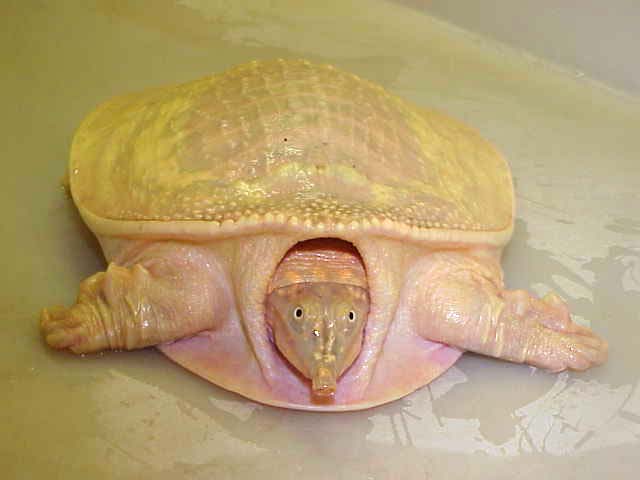Softshell Turtle - Florida
River Flyer, Pancake Turtle, Flatback Scientific Name: Trionyx ferox
Fri, 22nd November, 2024 - 4:01 am GMT
Sponsor Ads:

Alternative Name
River Flyer, Pancake Turtle, Flatback Scientific Name: Trionyx feroxBasic Info
The Florida Softshell gets its name from its leathery and scuteless shell. The rim of their shell is the only flexible part of their carapace, though the soft appearance of their shell would seem to imply otherwise. When younger, these turtles' shells are quite colorful, but as they age, their color diminishes. These Turtles have a flat, soft appearance and have an exotic looking tubular nose with fleshy lips. They use this unique adaptation to hide under mud and still be able to breathe while on land. The Florida Softshell has fully webbed limbs and three claws on each of these. Females in general are larger than males, with average individuals measuring approximately 20 inches, whereas males tend to be smaller, averaging 13 inches. Larger specimens have been reported.
Health
Florida Softshell Turtles are special animals with needs that may exceed the amount of dedication most pet owners are willing to give to its care. They are very cute and colorful as hatchlings, which initially lures pet owners into thinking that they are tiny and easy to care for. When well taken care of, Florida Softshells will grow very large, very quickly. These turtles can live for 30 years or more and the largest recorded female was about two feet across. They eventually require large enclosures (meaning a pond!) and a lot of food as well as time and energy. The hatchlings are also extremely prone to illness due to poor water quality and often develop a fungus, which is difficult to get rid of, and leads to the death of many softshells. These turtles are best suited for an experienced turtle pet owner who has time and money to take care of their needs properly.Habitat
Found in muddy or sandy-bottomed lakes, ponds, canals, and streamsBehavior
The Florida Softshell Turtle is an interesting looking turtle that makes a unique pet. The Florida Softshell is a turtle that, in general, does well with people as long as they are raised in captivity. They do have extremely powerful jaws and don't hesitate to use them if they feel threatened. They can deliver a nasty bite, not only to a human, but to other animals, such as interested cats and dogs as well. They are exceptionally fast and so should not be left unattended where there is an easy escape route. It has been reported that the softshell turtle will claw and hiss like a cat.Origin
North AmericaHistory
The Florida Softshell can be found in muddy or sandy-bottomed lakes, ponds, canals, and streams. They enjoy just floating around on the surface of the water, as well as climbing up on a fallen tree limb or enjoying a rest on the edge of the riverbank. They inhabit areas in South Carolina, Georgia, and of course Florida. The Florida Softshell uses its muddy habitat to hide in while awaiting its prey. They eat fish, snails, crayfish, and frogs in the wild. The Florida Softshell is also called the River Flyer - they should not be confused with the Fly Turtle from Australia. These are completely different turtles.Common Foods
N/ASponsor Ads:
To be simple is to be great. --Ralph Waldo Emerson
Softshell Turtle - Florida
Coded by: BGID® | ALL RIGHTS RESERVED Copyright © 2000-2024
Disclaimer | Privacy | Report Errors / Contact | Credits








 Homosexual behavior stems from the mind or genetics?
Homosexual behavior stems from the mind or genetics?  The Best Text Adventure You Will Ever Play! The official site:
The Best Text Adventure You Will Ever Play! The official site:  Why haven't we as a collective earth met with aliens yet?
Why haven't we as a collective earth met with aliens yet?  World EcoSystem - Biodiversity Changes - Who is on board and who isn
World EcoSystem - Biodiversity Changes - Who is on board and who isn  Mouthwash - Mouthrinse - Mouth Sores - Healing Infections - Gingivitis
Mouthwash - Mouthrinse - Mouth Sores - Healing Infections - Gingivitis  Treatment for Depression
Treatment for Depression  Ultra radical and violent Islamist group that even rivals Al Qaeda
Ultra radical and violent Islamist group that even rivals Al Qaeda  An idea to have teachers who want to carry guns to school undergo some level of police training will be left up to local school districts and police departments.
An idea to have teachers who want to carry guns to school undergo some level of police training will be left up to local school districts and police departments.